Brightlingsea Harbour Introduces Innovative New Electric Ferry
Brightlingsea Harbour Introduces Innovative New Electric Ferry
Brightlingsea Harbour has built Essex’s first sea-going electric ferry and is using it to service its expanding harbour cruise and charter programme.
The Brightlingsea Harbour Commissioners’ 2019 Capital Equipment Replacement strategy includes the requirement ‘to replace, as and when necessary, with more environmentally friendly equipment’. This strategy has led to the creation of ‘Colne Innovation’, an electric powered ferry coded to transport up to 12 passengers. The new vessel will not only reduce the environmental impact on coastal waters but also provide an ideal opportunity for the Harbours staff to develop skills operating electric passenger carrying boats.
Projects of this nature are normally funded with multiple partners contributing skills, expertise, money and equipment. Although we were lucky enough to receive grant funding of £5,000 from LoCASE (Low Carbon across the Southeast) funding elsewhere was unavailable so the remaining £25,000 came from internal resources, however it was possible to offset some cost by selling some engines and other parts unused in the build.
Although the idea was conceived in 2019 and orders placed for the electrical parts, delays caused by the Covid period meant delivery dates were set back by years instead of months. Finally, in September of 2022 the electrical equipment and batteries were received. In the meantime, a former fishing boat without engine had been purchased for £3,000.
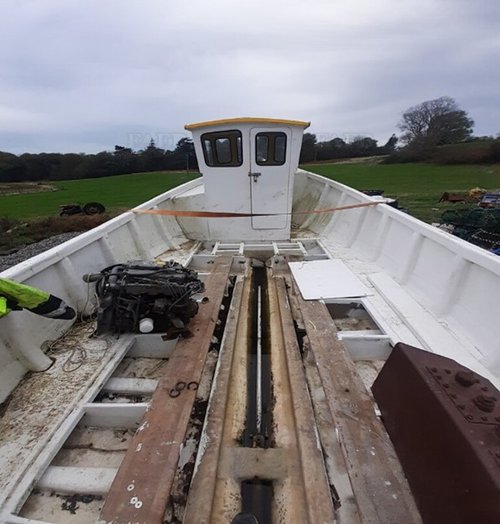
This boat, an IP 24, had been professionally prepared for life as a fishing boat, however a waning enthusiasm for the business meant only the hull work had been done, there was a prop shaft but no engine. It could not have been more ideal; the only problem was it was in a farmer’s field in Anglesey. Fortunately, a local Brightlingsea haulier, Matt Plant was able to pick up the vessel and did just that.
Once the IP 24 had been delivered in February 2023, the harbour team had to make a few adjustments and remediations to create a viable passenger boat, steering system, rudder, propeller, trailer to launch and recover, deck boards, etc, before the installation of the motor and batteries could commence.
Given the time of year and the impending season it was decided that work on the vessel would not start until April. The next two and a half months from early April were spent painting, cutting, sanding, glassing, welding, fabricating and fitting out, which led to the launch on 19 June 2023.
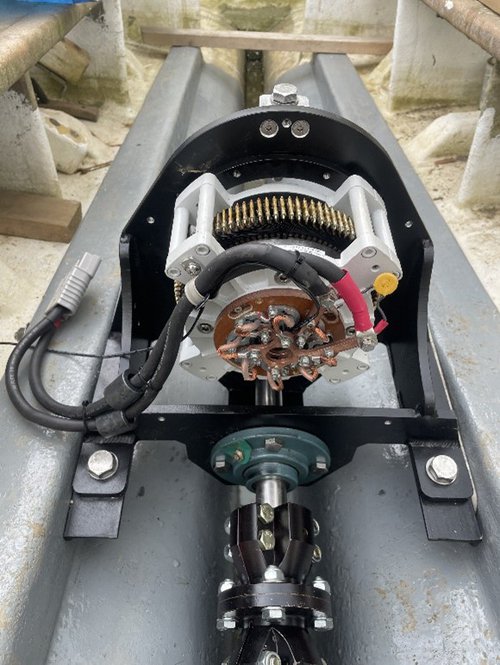
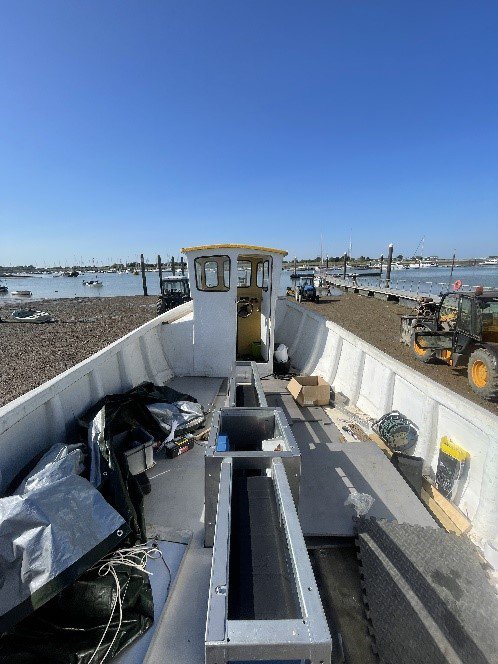
The following Monday the project’s financial partners LoCASE made a visit and were impressed; ‘‘The LoCASE team were very fortunate to be invited to Brightlingsea to experience for themselves, the results of the grant funding awarded by the LoCASE Project towards an electric engine to power the new harbour river taxi. The electric engine is estimated to save 3.27 tCO2e and 1,552.50 litres of diesel annually, which is great news for the local environment. Another bonus is the reduction in noise pollution, as the team found out, with the whisper-quiet engine humming discreetly in the background during the excellent tour around the harbour. Also great, is the saving being made against the costs of regular diesel fuel bills. All in all, a great project resulting in so many wins, both monetary and environmental. It is a great step-forward for the future of marine transport”.
The project is truly innovative and when breaking new ground with emerging technology it is inevitable that there will be a certain amount of trial and error involved in the early stages. Sea trials to test the concept and installation were the next stage, the vessel needed to be capable of making passage to Wivenhoe and back twice against the weather and the tide if required. The first run led to a cut out some four miles from Brightlingsea Harbour due to an overheating control box. Fortunately, the overheating was contained to the control box and the batteries remained cool, so solutions were sought.
Increasing efficiency by adjusting the propeller pitch and reducing heat were now the aim. Computer fans were fixed to the outside of the control box and tested. This time the vessel got further before overheating but still cut out, the lack of warm air extraction combined with cool forced air onto a specific component seemed to be the problem. So blower and extractor units were fitted and the problem was solved.
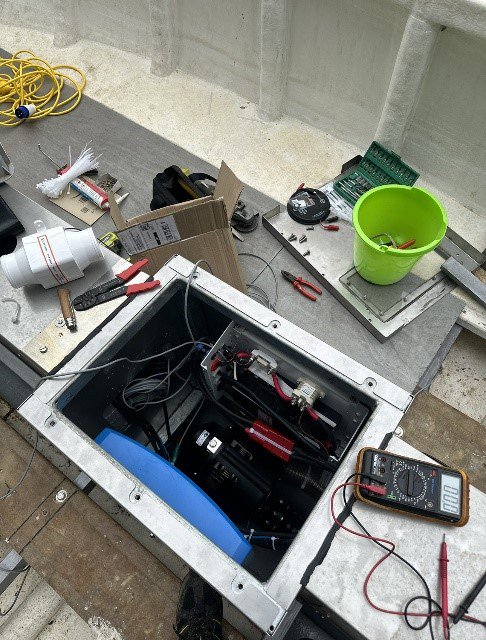
Project manager for Colne Innovation, Ross Bourne, said: “It’s incredibly exciting to be part of the harbour’s move towards a more environmentally sustainable future. I’m a qualified marine engineer and am still amazed at how little we know about alternatives to diesel and petrol. This project has really tested me, but at the same time been rewarding in equal measure, I now look forward to analysing the results, enhancing and improving the performance of ‘Colne Innovation’. This is the start; we need now to understand how technology can be integrated into our other vessels, to improve efficiency and maintain the environment”.
The Commissioners although influenced by the Government’s target of a 50% reduction in emissions from the maritime sector by 2050, are also committed to stakeholders by investing surpluses back into the harbour business. ‘Colne Innovation’ is a bespoke vessel designed to meet the requirements of a comfortable passenger vessel, providing protection from the weather, sea kindly performance, a quieter passage, great all-round visibility and the knowledge that you are not polluting the environment or creating unpleasant diesel fumes.
The project investment has come predominantly from the harbour’s own resources and has not been reliant on outside sponsorship or grant funding. Technical partnerships have been vital though and the team received superb support from Lynch Motors who supplied much of the electrical technology along with advice. Trevor Lees Director of Lynch Motors said; “Lynch Motor Company Ltd was asked to create an Electric Drive Solution for one of the working boats at Brightlingsea Harbour.
After a number of meetings and a site visit, the drive system offered was the Marlin 10, this is a 10Kw 48v solution along with a Lithium Battery pack which would meet the customers’ requirements, once the system was selected, we then had to create a bespoke housing and enclosure to ensure everything was included and kept within a framework along the midline of the boat.
This solution gave maximum free area for staff and customers to get around the boat.
Lynch have been Manufacturing and installing electric drive systems for over 30 years and have supplied to a large number of working boats all over the world, it is a pleasure to work with Brightlingsea Harbour and we will add details of the project to our list of application which can be found on our web site.”
To comply with local legislation, the boat had to be formally inspected and coded for 12 passengers by a marine surveyor, who was most impressed at the quality and layout but most importantly the drive. Surveyor Colin South commented; “First electric boat to be coded to TDC (Tendring District Council) – well done”!
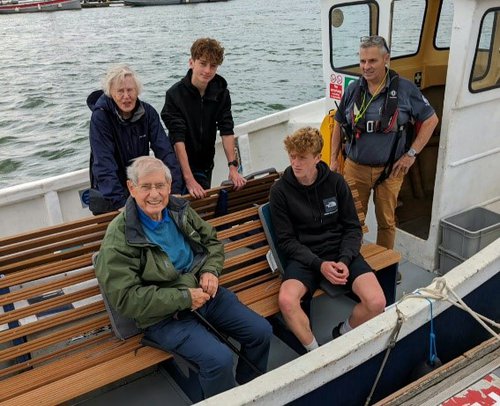
The Colne Innovation made its maiden charter on 21 July, a trip to Wivenhoe by Jonathan Crook as a gift to his parents. Jonathan said; “I hadn’t realised that we would be the passengers on the maiden voyage, of Essex’s first sea going electric boat, we feel very honoured”.
There followed a short period of snagging where a canopy was fitted to protect passengers from wet weather and on the odd occasion the hot sun. Then on 15 August the first Brightlingsea to Wivenhoe Black Buoy pub lunch cruise with a full complement of 12 passengers set off, One of the passengers Dave Smith reported; “I really enjoyed my trip up to the Black Buoy the crew on board were really friendly and informative along the River Colne up to Wivenhoe. The trip was made a lot better when I found out we were travelling on “Colne Innovation”, the harbour’s new electric boat it was nice to hear it was more eco-friendly. It was a very good trip, and I would recommend as a day out to all, great for all ages!”

With the ferry now in operation the team are studying the statistics and ideas to see how the vessel’s operating efficiency can be improved. It turns out that she uses approximately 20% of the useable load for a return trip, ensuring that she can more than meet the design requirement that she be capable of making two return trips between mains charging sessions. Solar panels will be added in the future to reduce the amount of mains charging required and extend her potential service time. In addition, a small mizzen mast with a simple sail could be added which may help to balance the boat in choppy conditions and assist in powering it. The prevailing south-westerly and north-easterly winds in the Colne make for reaching conditions between Brightlingsea and Wivenhoe and the sail will certainly another add power and ease the load on the batteries. Harbour Master James Thomas said; “Technological advances always seem to be handed down to us, the operator has much to add to the efficiency through knowledge and experience. It will be a combination of people, process and technology that will lead to significant advances in electric vessels. We’ve started now and have much to learn, but also much to contribute. We look forward to sharing what we know and would welcome anyone reaching out to us. We can also look at alternatives to the grid for charging. Using the environment; wind, sun and tide to produce enough power to charge our batteries is our ultimate goal”.
The questions anyone setting out to introduce an electrical vessel into their fleet will always ask include, how long do the batteries last before they need charging, how fast can we go, how long do the batteries take to charge and how much does it cost to charge the batteries.
Brightlingsea Harbour’s IP 24 ‘Colne Innovation’ can transport 12 persons plus skipper to Wivenhoe, 11 miles return passage, uses approximately 4kw, achieving speeds of 5kts, more when the wind and/or tide are favourable.
To charge the batteries from empty takes 7hrs and costs £2.45.
To charge the batteries from 79%, the typical residual following a charter, costs £0.80.
The equivalent cost for the traditional diesel ferry is £20-25 per charter, depending on the weather and tide.
Interestingly, earlier in the sea trials when Colne Innovation cut out, it was towed by a workboat for a period, during this time the propellor generated a charge and recharged the battery to 100% very quickly. This is an observation we will look to explore in future.
As well as being used for regular Harbour and River Tours, ‘Colne Innovation’ is also available for private charter for groups of up to 12 people. Further information about the tours and charters can be found at the Harbour Commission website.

For more information about the ‘Colne Innovation’ project please contact James Thomas, Harbour Master, Brightlingsea Harbour Commission on hm@brightlingseaharbour.org
